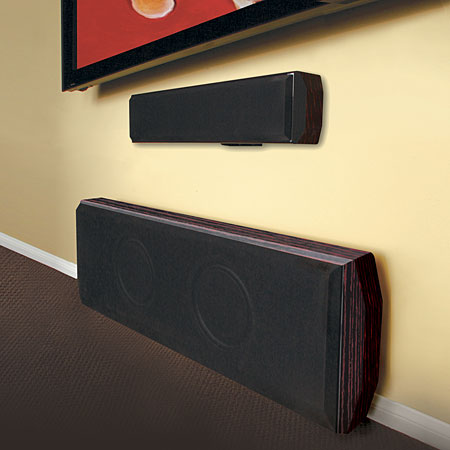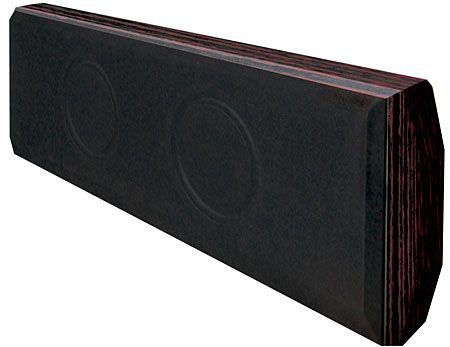Sunfire SubRosa Flat Panel Subwoofer
On-wall speakers are a hot product category these days, driven by sales of flat panel televisions. On-walls are a logical counterpart to these sleek displays, and many offer great sound quality, but there is one glitch: the subwoofer. Since on-wall speakers have smaller woofers, they usually require a subwoofer for full, visceral bass response, especially important when watching movies. So, where do you put a boxy-looking subwoofer that can't be stuck on a wall? In-wall subwoofers are one option, but require more work and hassle than many homeowners are willing to tackle, especially a retrofit installation. Stashing the sub under a table works, but it's still a square box on the floor and its placement options are more limited.

Sunfire has another idea: the SubRosa flat panel subwoofer ($3,500 as reviewed). SubRosa is part of the company's XT Series of upscale home theater products. The model number is SRS-210R, but it's called SubRosa, which means 'hidden in secrecy' or 'behind the scenes' in Latin. The SubRosa is a cool looking alternative to a square box subwoofer, it nicely matches Sunfire's Cinema Trio LCR on-wall speaker system and, most important, it delivers deep, solid bass for music and movies.
Sounding Out the SubRosa
Sunfire is based in Snohomish, Washington and was founded by Bob Carver, an industry veteran and audio innovator who's always thinking ahead to his next project, never satisfied with the status quo. He likes to invent new, creative solutions to problems, such as the SubRosa. His legacy includes the Phase Linear line of stereo amplifiers (circa 1970s), the Carver line of speakers and electronics, and now Sunfire.
At 14 " high, 44 " wide and only 3 " deep (!), the SubRosa, with its hand-rubbed Rosewood finish, might look more like a unique home furnishing than a speaker. The black grille on the front is the only feature that gives it away. It also matched the finish on my two Rosewood coffee tables!
Sunfire offers four installation options for the SubRosa- three in-room and one in-wall. If used as an in-room sub, it can sit on the floor horizontally or vertically with the drivers facing into the room. When sitting horizontally on the floor, the bottom of the subwoofer is supported by two easily attached black steel stands. When standing vertically the bottom of the SubRosa rests on one stand and the top is secured to the wall with two rubber mounts to prevent it from tipping forward. It can also lay flat on its back with the drivers facing up, such as under a chair or couch.
But why would you want to hide it? The in-room version is a great space saving idea with a beautiful finish. The in-wall version, known as the SRS-210W, comes in a utilitarian black finish and fits neatly in a standard 3 1/2" deep residential wall cavity.

At the heart of the SubRosa, beneath the finish, are two low-profile 10" woofers with die-cast frames and ultra-strong Neodymium magnets. The low profile design allows the woofers to fit in the shallow 3" deep enclosure. The two woofers output a lot of bass and as a result the SubRosa employs Sunfire's StillBass anti-shake technology to eliminate annoying wall vibrations. To avoid a painstaking discussion of physics and Isaac Newton's 3rd Law of Motion, I'll provide a simplified explanation. The anti-shake feature uses an IBeam device inside the enclosure to counteract the motion of the woofers and eliminate cabinet shaking and reduce vibrations. . The IBeam is a transducer with a magnet structure, like a woofer, but instead of a cone or diaphragm, the IBeam drives a heavy mass that moves out of phase with the woofers. When the woofers move in, the IBeam structure with the heavy mass moves the opposite direction. It's the principle of equal-but-opposite force at work (OK, a little bit of physics). The IBeam is driven by the amplifier and is mounted directly to the back of the baffle inside the enclosure. It must work, because the cabinet doesn't shake and vibrations are hardly noticeable, even when the subwoofer is played loudly.
SubRosa SRA-2700EQ Amplifier
The stealth looking SubRosa requires an outboard amplifier in the form of a 2700-watt rack-mountable monoblock amplifier, the SRA-2700EQ. To connect the SubRosa amp to the system, connect the Sub/LFE output of your AV receiver or preamp/processor to the sub amp, or connect the SubRosa amp between the pre/pro and power amp if separates are used. Or, you could also use the left and right pre-out/main-in connections on a receiver provided that it's equipped with main-ins, which is not as common as it once was. In the latter two cases, the left and right channel outputs or pre-outs would go into the line/ins of the 2700EQ, and then the left and right line/outs of the 2700EQ would go to the left and right channels of your power amp in the case of separates, or to the main-ins of an AVR so equipped. The AVR or pre/pro would then be configured for "Large" left and right speakers, and no sub, which would route bass from the LFE channel and any speakers designated as "small" to the left and right speakers, and thus to the SubRosa.
I obtained the best results by connecting the sub amp between the Meridian pre/pro and amp in my two-channel reference system and using the crossover in the SRA-2700EQ. For my home theater setup I used the pre-out/main-in connections on my Yamaha AV receiver.
In addition to basic features, such as volume, crossover frequency and phase, the SRA-2700EQ amp includes Sunfire's four-band Auto EQ room equalization feature. Bass is the most troublesome range of frequencies for home theater installations because of room resonances. It's an unfortunate reality, but if the bass isn't right, nothing sounds good. Conversely, when the bass is tight and has good definition, it follows that imaging, soundstage and tonal balance seem to 'snap into place'.
During a recent discussion about room acoustics with Art Noxon, President of Acoustic Sciences Corp. (which makes a variety of acoustic treatment devices, including Tube Traps), he described the holy grail of good bass response as the ability to hear the 'inter-sonic' silence between notes – each note should be distinct, not simply a muddle of low frequencies. Correct subwoofer and main speaker placement help a lot, but an equalizer used correctly can also help immensely. The Sunfire Auto EQ can equalize the SubRosa automatically with the help of test tones built into the SRA-2700EQ and a microphone (included). Or it may be done manually by adjusting the four-band manual EQ to suit listening preferences. Sunfire recommends using the Auto EQ first, followed by tweaking the manual controls as necessary to fine tune the bass.
The Auto EQ feature works by placing a microphone at the listening position and activating a series of low-frequency test tones. The test tones are picked up by the microphone, which measures the peaks and dips in bass response found in a typical listening room and equalizes or smoothes out the bass response. My listening room is no exception and the Auto EQ effectively reduced a lot of the room resonances. Bass was tight and punchy with a noticeable absence of heaviness or boominess. The only additional adjustments I found necessary were for sub level, which varied based on program material.




























































